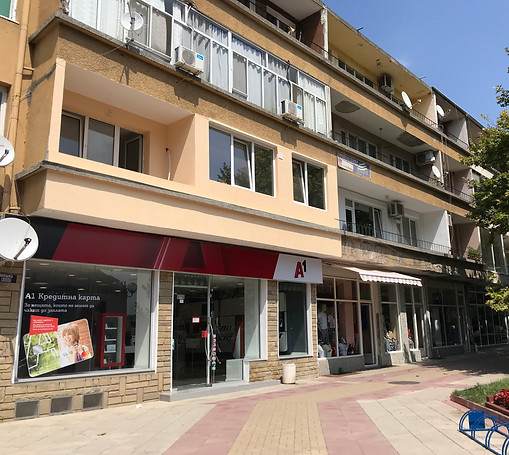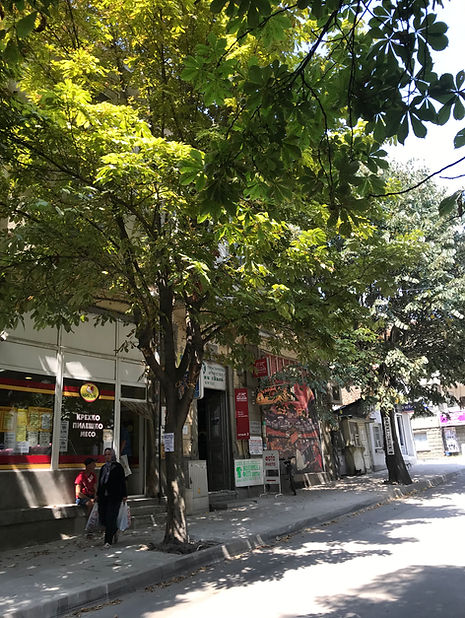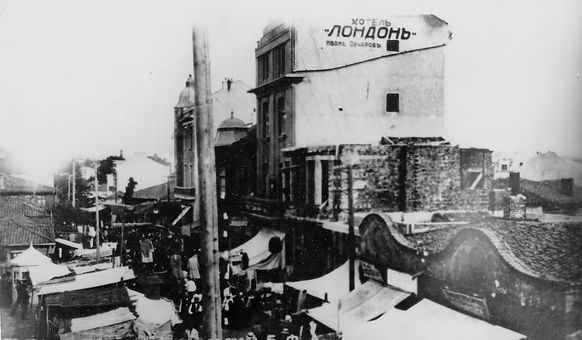Aytos
Aytos is a town in the Burgas Province, located in the southeast. It began as an ancient village, built by the thracians. It’s changed locations a total of three times, but is currently nestled along the lower parts of the Balkans mountains. The name of the town, which is translated from greek, means eagle. The towns shape does indeed look like an eagle, which has stretched out it’s winges on the foot of the Aytos mountain. There are numerous legends for the origin of the towns name. According to an ancient legend, the village was founded by Aetos (eagle) - a student and follower of Orpheus. The other legend goes as follows: while a man was out hunting, he was attacked by a bear. An eagle came and pecked out the bear’s eyes. While the hunter was unconscious, his hunting group came and killed the eagle, believing that it had attacked their friend. When the hunter woke up, he explained what had happened, but it was too late. To this day, the eagle is a symbol of the town. During the awakening period (1800’s) and the early 20th century, the town's name was “Orlovo” (bulgarian for eagle) or “Orlovgrad”, and was known for its fairs. Aytos has always been an administrative center for the surrounding villages. Today it’s a municipality which includes 16 villages and an area of 444 mi². During the Balkan war, refugees from eastern thrace settled in town and created the neighborhoods “Hisarya” and “Strandzha”. According to the National Statistics Institute, as of December 31st, 2018, the towns population is 19,327, which makes it the second largest populated area in the province. The towns population mainly consists of christians and muslims. There isalso representatives of the “Universal White Brotherhood”. The regional mufti (muslim legal expert) is located in Aytos.The towns holiday is on October 26th, Saint Dimitars day.
Town Square
The old picture shows a row of old buildings, which no longer exist. The white, two-story building, used to sit at the beginning of the town square garden, where the benches are. The three buildings found to the right of the white one, were located in front of the cafe “JOY”, where the statue of the mother with the children is. After comparing the photo with a postcard sent in 1941, it can be concluded that the photo was taken that year, or a little before, because in ‘41 the muddy square looks as if it was tidied up, and the path on the right side was paved, rather than being a dusty trail.


Town Square
The square "Freedom" (or "Liberty") is found in the town center, next to the city hall and main street. It's named after a group of liberators, who were welcomed there. During the years, the square has looked in different ways; a full renovation was last done in 2008. Since then there has been a fountain, benches, and an open-air stage, where cultural and community events are often held.


Main Street
Today, the main street is slightly covered by the large tree so it's hard to tell, but almost all of the old buildings were town down and replaced with the current ones during the socialist period, except the one that houses cafe "NRG". The sign under the balcony (old picture) has some writing on it, but it's barely legible. On the first row it says "store", the second you can't see, and on the third it seems to say "with various ... goods". At the very bottom it says the name of the owner - Nissim Solomonov. The photograph gives a valuable glue to the towns population almost 100 years ago. Before in Aytos, and in all of Bulgaria, there was a significant Jewish population, but after World War II, most of them immigrate to Israel. Aytos' Jews lived in the northern part of the town, where there was a synagouge and a water fountain.During the Second World War, Georgi Parashkevov sheltered Suzana, Albert, and Sofka Koen, a Jewish family, during a police raid.


Cafe - pastry shop
The cafe - pastry shop was located in the building of the tourist association, which belonged to the wealthy merchant, Yordan Kochev. The building is considered an architectural monument of culture in the town.


DSK Bank
From 1948 to 1958, there was a people's council for the "okoliya" (county), which served as a local authority for the national government and the people's self-government. It consisted of advisers, chosen from the area of the county, who had to give reports of their activities to the people. In their activities, the advisers often took up initiatives of the people, and closely worked with political, professional, and other community organizations. For many years now, the former building of the people's county council, has been used as a branch for the DSK bank.


Ludzhata
For centuries, the Aytos region has been well known for it's mineral water. In the villages surrounding the town, there's a lot of water fountains, from which warm, drinkable, water flows. The "Ludzha", from which cold spring water flows, is found near the town square. A pipe system and a big drinking fountain were built in 1928, but now the water runs from 7 separate spouts. The water runs around-the-clock and there is frequent check ups on the water quality.


Old buildings
The building is found next to the junction of the st. “Svoboda” (“Freedom”) and st. “Aleksandar Stamboliyski”, close to the community center and right across from the former doner kebab restaurant.


Apartments above clothing store
During communism, the sewing and knitting of clothes at home, or going to a seamstress and fitter, was still common. However, during the later years, ready-to-wear clothing stores opened, which were stocked with mass produced items.


Tourist Assosiation
The tourist association "Wonderful rocks", was created in 1903. The first chairman of the association was Nikola Boev, who was a bookkeeper and very involved with the community. He was also one of the first teachers in the old three-room school. The name of the tourist association, "Wonderful rocks", comes from the natural landmark, found in the Dulgopol county, Varna. It's located on the shore by the river "Tsonevo", and is made up of three rock formations, a result of erosion. the rocks are near the Aytos-Provadiya road, but through them there is also three dug out tunnels. Even though between the town and the rocks there is 44 km (27 mi), the landmark is an important part of Aytos' history and culture.


Ethnographic complex "Genger"
The name of the Ethnographic Complex "Genger", comes from the conversational name for the Aitos Astragalus, which is only found in the towns area. The word genger is of turkish origin and means prickly shrub. The plant is collected for the first time from the heights of the nearby village of Karageorgievo, by Professor St. Georgiev, in 1888. At first, scientists think that the plant is not only found in Bulgaria, but also in Crimea and the Caucasus. However, when botanists from Georgia visit Aytos, the plant is categorized as new. Currently, the species is included in the Bulgarian list of endangered plants. The people of Aytos are equally proud of their unique plant and their ethnographic complex, which is similar to the "Etur" in Gabrovo (in fact, it's sometimes called "Etur" instead of "Genger").


Bridge next to the farmers market
The bridge is found next to the bazaar (farmers market) and goes over the Aytos river, which flows from the Aytos lake. It’s unclear when the bridge was built, but it was definitely before the change of power (1944). The current bridge is suitable for pedestrians and automobiles.


Cafe "NRG"
There isn’t a lot of information on the building, but judging by the facade, it was built in the first 30 years of the 20th century. Before 1945, the bottom portion served as a store and later during the communist regime as an office for the national cooperative union (COOP), while in recent years it has been a cafe. The building, or at least the top part, looks absolutely the same. In fact, if it wasn't for the difference in quality, you wouldn’t be able to tell that one of the pictures was taken about 40 years ago.


Town Hall
The Aytos municipality serves as an administrative body for the town and the villages nearby. An interesting story, connected with the municipality, is that of Enyo Georgiev Klyantev, who was mayor of Aytos a total of three times from 1923 to 1934. In 1944, he was accused by The People’s Court of acting like “an utmost representative of facism”, and that all interviews, firings, and arrests (of communists, jews, partisans, etc.) happened under his watch. Furthermore, he was accused of openly vilifying and criticizing the soviet union. In his response, he pleads to be fully excused of his crimes, because he didn’t commit them, nor did he give permission for them to be carried out. He creates a long list of witnesses, which he claims will confirm his innocence. Part of them would have proved, that to the best of his abilities, he had advocated for all “motherlandfrontierers” ( essentially, communist-supporting patriots) and especially all the “national communist-warriors”. The professor Georgi Pavlov, would be able to confirm that he would often complain about the old government administration (referring to when Bulgaria had a monarchy). He also points to a group of jews, who would confirm that he always took care of them, and that thanks to his advocacy, they were never mistreated. In fact, according to him, these actions had brought on the disapproval of the fascists. Mrs. Dzhankardashliyska, the clerk for the town mufti, would confirm, that he always advocated for the rights of the minority, and that he was never racist. However, according to the information given by the regional chief of police, he was the perpetrator The People’s Court made him out to be. On May 21st, 1944, the Chengeliev’s home was burned down and the dead bodies of the partisan brothers Ivan and Dimitar Chengeliev, their mother’s, and Atanas Manchev’s, were put on display in the town square. According to the accounts of the chief of police, Klyantev spent the whole day with the leader of the gendarmerie (they’re the ones who killed them) and partook in the act with them. He also mentions the killing of 29 partisans from the village of Malka Polyana, the jailing of 15 antifascists, the sending of 30 people to labor camps, and the firing of antifascists from their state and municipality positions. From the published documents, it’s not clear what his sentence is, but in his handwritten afterword, he pleads for the court’s judges to keep in mind that he suffered a lot as a child, because from a young age he had to work in other people’s shops and grocery stores, and that when he became a member of parliament, he was once again unhappy, because he had no experience. He claims to have always helped those in need and that he never chased away the nation loving partisans. For these reasons, he pleads that they lower his sentence to a minimum, so he can be useful to society and so that he can enjoy the new regime.


Park "Nightingale River"
Park "Slaveeva Reka", translated to "nightingale river", was created in the begging of the 20th century, by the Thracian Stoyan Toshev, nicknamed "Green" (reference to nature). Toshev was born in Lozengrad, part of modern day Turkey, in 1884, and is responsible not only for creating the park but also the town garden. In the park there is walkways, sports fields, playgrounds, fitness equipment, and a zoo. In 2016 it was announced that the municipality had a project planned for the park, worth 1.6 million leva. The park had't been renovated in 30 years; everything was finished in 2018, just in time for the 50th edition of the folklore festival "Slaveevi Noshti" ("Nightingale Nights").


Ethnographic Complex "Genger"
The complex was built in 1988, with the goal of preserving Bulgarian craftsmanship, especially those typical for the Aytos region. In the so-called "alley of craftsmanship", there is ateliers for copper work, baking, basketry, applied arts, and pottery. Out of all the crafts, the pottery is most well known, because it's kept up by the Aytos family Orlovi. The family has been making pottery since 1826, when there was many potters. Eventually, they become the only ones, and after 1944 the grandfather of Atanas, the current craftsmen, opens a workshop, which is later closed. Years ago, Atanas once again opened up a workshop, where he continues to produce different pottery. The family has a store in the complex and now for six generations continues to create.


T Market


Army apartments
On the territory of the city there is a large military unit, which houses the 24th mechanized tank brigade - a military formation of the land forces of the Bulgarian army. The brigade was officially established in 1961, and on October 27, 1962, at a solemn ceremony in the center of Aytos, the battle flag was also handed over. In addition to the various exercises, the personnel of the 24th Brigade also participated in the construction of a number of landmark sites such as Kozloduy NPP, Kremikovtzi Plant and Sunny Beach Resort. In addition, the formation provides assistance to the civilian population in various disasters and accidents. In 1981 he was awarded the Order of Civil Valor and Merit after rescue operations during the blizzard of the winter of the same year. In connection with the reforms in the Bulgarian Army, the 24th Panzer Brigade was liquidated in 1998, by order of the Minister of Defense. On the territory of the unit there remains only a training center for training recruits, which was closed a few years later - in 2003.


Post Office


Apartments by the town square


Old court house


Town Square


Center for services
A combine is a union of production / manufacturers or workers, who offer different services in one location. Bitov combines (the word bit refers to anything from the everyday life of a group of people) offered services needed on a day-to-day basis. In this one, there was a hair salon, a barber shop, a beauty salon, a radio-television service, a shoe shop, and more.


Spring fair
"Aytos is a quaint town with a famous fair, where merchants who are constantly coming and going." - Minas Puzhushkian. In Aytos, for many years, fairs were organized, but in the original meaning of the word. The fairs were big pazars (markets, similar to bazaars), which were organized once a year. They would put goods and samples on display, make commercial transaction, and were a place for making new contacts and for showing off workmanship. During 1898, the fair took place on Orthodox Palm Sunday, but the exact date of the picture below is unknown. The stalls ran along the length of the town square, and you can see the sign for hotel "London", which was owned by Ivan Ovcharov.


Community center "Vasil Levski 1869"
It's not a coincidence, that the first school and community center in Aytos, where created during the 1860's. During this time in Aytos, and in all of Bulgaria, there was a huge wave of Greek influence, because the nation didn't have it's own church. The people who were wealthy enough to educate their kids, often had grecoman ("greek pretender" / pro-greek culture) tendencies, and sent their kids to greek schools. A few guildsmen however, inspired by the Bulgarian revival movement, called on the teacher Gospodin Dimov Buchvarov from the village of Medven in Kotel, to create a new institution. Together with the economist Dimitar Stanchev and the teacher Apostol Dyakov, they start up the community center under the name of "Budnii Muzh" ("Woke Man") in 1869. Later on, the name is changed to "Izbavitel" ("Savior") and a group of 81 Bulgarians started to edit and publish a large amount of magazines and newspaper, but according to the newspaper "Turtsia" ("Turkey"), it gets closed down by a group of two or three Bulgarians. In 1875, the center opened doors again, but it's activity dies down in the 1890's. In 1898, it receives the name "Suglasie" ("Agreement"), the library is stocked up with new books, and theatrical shows are organized. During the first decade of the 1900's, the community center changed it's location multiple times, and in 1916 it changed it's name to "Razvitie" ("Progress"), but the years of unrest that followed (WWI and Bulgarian coup d'état of 1923), caused it to cease operation once again. The name is changed to "Vasil Levski", during a 1928 meeting, where they also decide a building needs to be built for the center. During the '30's the idea is discussed and a fund is started ; for 6 years, 3,500,000 levs were collected. In 1946, a contest for the building design is won by an architect from Sofia, Dimitar Pisinov, and in 1947 Gyuro Lazarov, Ivan Gyurov, Angel Katsarov, and krum Katsarov, where chosen as project developers. The digging began on June 2nd, 1947, but construction wouldn't end untill 1956. The community center's history is a long one, 150 years to be exact, and it is one full of difficulties, but it is also one that fills the town with pride!

.jpg)


Ducklings Courtyard

